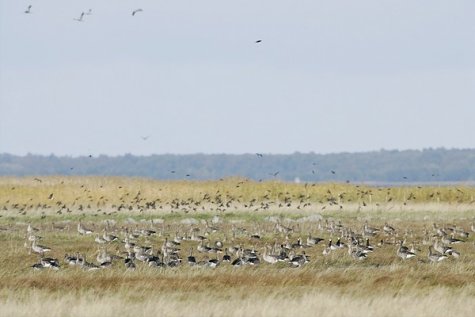Final results of birdwatch days
Photo: Arne Ader
Translation: Liis
Salmi shore meadow. Matsalu
The international birdwatch days took place on October 5-6. 41 European countries were engaged in the event - arranged for the 20th year already - where millions of birds were observed. The Estonian Ornithological Society received 119 watching lists, which more than 330 people had contributed in setting up. Observers counted altogether 231 000 birds of 165 species during the two days. The most abundant species was, as is usual for this time of the year, barnacle goose (95000 birds); it was the only species to migrate noticeably during these days. They were followed by starling (9200), mew gull (6600), wigeon, lapwing and chaffinch (all 6300).
Most frequently seen species were great tit, hooded crow, blackbird, jay, magpie and great spotted woodpecker. The rarest species encountered was crested lark, but this bird has been in place in Pärnumaa, in the Munalaiu harbour, already for a long time.
Bigger surprises were instead offered by late migrants that should already have been on their way to the south. For instance nightjar, common swift, spotted flycatcher, redstart, shelduck, house martin and others.
Surprisingly many of Estonia’s national bird, barn swallow, were also seen. Compared to previous years the average number of observed birds was lower, but the number of species higher than average. The cause is the persistently warm weather.
The Estonian Ornithological Society thanks all participants, and the guides who organised birdwatches for enthusiasts in 10 places. Special thanks to Kristjan Adojaan and 5D Vision OÜ, who as a voluntary contribution created the online observation form for the watch days.
The final results of the birdwatch days are on the EOÜ home page:
Additional information:
Riho Kinks









